The most effective remedy for all strawberry diseases is proper care.
Modern strawberry varieties are quite disease resistant. With proper agricultural technology, diseases do not cause severe damage to the plantation. Nevertheless, many gardeners complain about outbreaks of garden strawberry diseases on their plots.On this page you will find a description of the most common strawberry diseases and effective ways to treat them.
Strawberry diseases and their treatment
Gray rot
|
The causative agent is a pathogenic fungus. It is preserved in petioles and dead leaves, damaged berries and not removed from the plantation. A very common strawberry disease. |
Description of the disease. On leaves, peduncles, flowers and ovaries it appears as large brown drying spots that do not have a border. In hot weather, the spots crack. In rainy weather and high humidity, a smoky-gray coating appears on the affected tissues.
Affected berries become soft and a wet brown spot appears on their surface. The mycelium itself develops in the pulp, and spores appear on the surface in the form of a gray coating. Affected berries are unfit for food and must be destroyed. The disease manifests itself in damp, rainy summers. Overgrowing the plot with weeds, growing strawberries in the shade under dense crowns, and dense plantings contribute to the rapid progression of the disease.
Ripe strawberries are more affected by rot. Green ones are more resistant and are affected if there are diseased red berries nearby.
Methods of treatment. In damp weather during the budding period, strawberries are sprayed with a broad-spectrum fungicide Euparen. This drug is most effective in the fight against gray rot and white spotting, and also suppresses the causative agent of powdery mildew. Euparen should not be mixed with Bordeaux mixture and adhesives should not be added to the working solution. 2 g of the drug is diluted in 1 liter of water, consumption per hundred square meters is 6 liters. After harvesting, a second spraying is carried out.
To combat infection, strawberry bushes can be sprayed with bacterial preparations Planriz or Alirin B.
During the period of ovary growth in damp weather, diseased strawberry bushes are pollinated with fluff.
Traditional methods of treatment.
- Garlic infusion. The husk is poured with 5 liters of hot water and left for 2 days. The resulting infusion is diluted with water in equal proportions and the bushes are watered.
- Prepare a solution from ash (1 cup), chalk (1 cup), copper sulfate (1 tsp). The mixture is poured into 10 liters of water and sprayed onto the strawberries.
Disease prevention.
- Thinning thickened plantings.
- Removal of plant residues.
- Removal and destruction of rotten berries.
- Strawberries should not be irrigated by sprinkling during flowering and ovary growth.
- To prevent damage, freshly reddened and not quite ripe berries are removed.
- After each rain the earth is loosened.
It is advisable that ripe berries do not come into contact with wet soil; for this, special support rings (sold in garden stores) or plastic bottles are placed under the bushes. You can mulch the ground with any material except peat.
White spot or ramularia
Fungal disease. The infection persists in affected overwintering leaves and plant debris. Strawberries grown in heavy soils with excess organic matter are more susceptible to ramularia.
Description of the disease. Affects leaves, peduncles, stalks, sepals. Numerous small red-brown spots of round or angular shape appear on strawberry leaves. As the mycelium develops, the spots turn white, but a brown border always remains around them. In hot weather, the affected tissue cracks and falls out; in humid weather, a white coating of sporulation appears. The spores spread to neighboring leaves and plants.
On the peduncles, stalks, and sepals the spots are dark brown, turning white over time.They are elongated and slightly pressed. With severe damage, the flower stalks become brown, thin, fall and dry out.
The first signs of the disease on strawberries appear in early to mid-May; in summer, rainy weather contributes to the spread of infection. A large amount of moisture in the soil after snow melts also contributes to the development of the disease.
Methods for treating strawberries.
- 3-4 times treatment with Bayleton: during the period of leaf growth, when flower stalks extend, after harvesting and 10-12 days after the previous treatment.
- Double treatment with Euparen. You can do 4 treatments, alternating Euparen and Bayleton.
- Spraying with Nitrafen. The drug has a broad spectrum of action, can accumulate in the soil and cause burns to plants, so it is used once in early spring or late autumn.
- Double treatment of strawberries with Bordeaux mixture: before flowering and in the second half of July. The leaves are processed from the underside.
Traditional methods of treatment. Spraying strawberries with a 5% iodine solution (10 ml per 10 liters of water). Treatment is carried out on the leaves before flowering.
Disease prevention:
- removing dry leaves in early spring;
- thinning a thickened plot;
- weed removal;
- burning of all damaged plant residues.
White spot (and all strawberry diseases in general) develops greatly when the bushes are overfed with nitrogen. When a lesion is detected, nitrogen fertilizing (both organic and mineral) is stopped and phosphorus-potassium fertilizers are applied. The best of them is ash.
Brown spot
The infection is caused by pathogenic fungi. Preserves in affected plant debris and affected overwintering strawberry leaves.
Description of the disease. The disease affects the above-ground parts of plants.Numerous round or angular spots appear on strawberry leaves, the color of which ranges from red-brown to almost black; the middle of the spot is somewhat lighter, but without a border. They can merge. Soon black shiny pads with spores appear on the spots. If the infection is severe, the leaves turn purple and die.
On leaf petioles and tendrils, the disease manifests itself as depressed small brown spots.
This strawberry disease appears in the second half of summer and, if widespread, can cause browning and premature drying of leaves, which negatively affects the winter hardiness of strawberries. Humid and hot weather promotes the development of infection. But at temperatures above 32°C, even with high humidity, the development of the disease slows down.
Prevention and treatment of the disease
- Preventive spraying with Bordeaux mixture. If the disease spreads strongly, treatment is carried out in spring and autumn.
- If more than half of the plantation is affected, treat with Nitrofen.
Powdery mildew
The causative agent of the infection is a pathogenic fungus. Its spores are stored in the affected plant tissues and on plant debris. The source of the disease consists of mycelium and numerous white spores, which, spreading, infect surrounding strawberry bushes and other plants susceptible to powdery mildew.
Signs of defeat. A white coating appears on young strawberry leaves on both sides and on the petioles. The edges of the leaf blades wrinkle and bend upward like a boat, the lower surface acquires a bronze-pink hue. Peduncles, flowers and ovaries turn brown and become deformed. Green berries dry out. The red berries become slimy and appear sprinkled with flour, and a characteristic musty smell appears.The disease manifests itself in damp summers and when the watering regime is violated.
How to treat strawberries.
- Treatment with fungicides based on colloidal sulfur or copper sulfate. Preparations containing sulfur are more effective. Bordeaux mixture containing copper sulfate is ineffective against powdery mildew.
- Treatment of strawberry plantation with colloidal sulfur. The drug can be used 3 days before picking berries (Tiovit Jet).
- The drug Topaz is the most effective in the fight against powdery mildew. The duration of the therapeutic effect is 3 days, the prophylactic effect is 7-10 days.
- Fitosporin is very effective at the early stage of the disease, but in advanced forms it does not have the necessary effect.
- Copper sulfate can be used once per season, since the drug is toxic. Sprayed to prevent and treat the initial stage of infection in early spring.
- Can be treated with other fungicides: Skif, Skor, Tilt, Quadris, Zato.
- Spray the bushes very strongly, the solution should drain from the leaves.
- You can water strawberries only when the top layer dries.
- Stop fertilizing with nitrogen fertilizers.
Traditional methods of treatment are more suitable for preventing disease than for treating it.
- Iodine. 10 ml are diluted in 10 liters of water and sprayed on the strawberry bushes from the bottom and top sides. Effective in the early stages of the disease.
- Soda. 5 g of soda ash is diluted in 1 liter of hot water, adding soap shavings to the solution for better adhesion of the drug. After the solution has cooled, spray and water the soil. Spraying is repeated 3 times with an interval of 7 days.
- Potassium permanganate. 1 g/4 l of water. Carry out 2-3 treatments with an interval of 7-10 days. Spraying must be done after rain.
- Serum. 1 l/10 l of water, spraying strawberries every 3-5 days.The serum coats the plants with a film and prevents the growth of the fungus, making it difficult for it to breathe. In addition, fermented milk microflora is an antagonist of pathogenic fungi. It produces substances (antibiotics) that kill fungi and their spores.
As the disease develops, people switch from folk remedies to chemicals.
Brown (angular) spotting
The pathogenic fungus mainly affects old leaves. Pycnidia, the overwintering fruiting bodies of fungi, form on the affected tissue. Overwinters in affected tissues and on infected plant debris.
How does the disease manifest? The disease appears in mid-summer and reaches its peak in mid-August to early September. Red-brown spots with a light center and a dark border appear on the leaf blades. Rapidly increasing along the veins or from the edge of the leaf to the center, they acquire an irregular angular shape. Gradually the spots become gray-brown, but the border remains. In hot weather, the affected tissue cracks and falls out.
When leaf petioles and vines are damaged, oval brown spots and dry constrictions appear on them. When the stalks are damaged, the ovaries become brown and dry out. Wet weather contributes to the spread of the disease.
How to treat strawberries.
- When the disease appears after picking the berries, mow down all the foliage and spray it with Nitrafen before it grows back.
- Before flowering and after fruiting, diseased strawberries are sprayed with Bordeaux mixture.
- Treating the plantation with Ordan.
Traditional methods of treatment.
- Ash. 1/2 bucket of wood ash is poured into 10 liters of water and left for 3 days. Bring the volume of the solution to 30 liters, add an adhesive (soap, milk, kefir) and spray the strawberries.Diseased strawberries are treated twice with a 10-day break.
- Kefir. 1 liter of fermented kefir (yogurt, old fermented baked milk, etc.) is diluted in 10 liters of water and sprayed on strawberry bushes. Carry out 2 treatments with an interval of 12-14 days.
Late blight
A fungal disease, the pathogen persists in the soil for 8-10 years.
Description of the disease. All parts of the plant are affected. The roots become bare and die, and the central cylinder of the root turns red and the rhizome is destroyed. Ring-shaped brown spots appear at the base of leaf petioles. Peduncles or already formed berries often dry out. Dry spots appear on the berries, which increase in size and affect the entire surface; the berries acquire a brown color with a purple tint, become hard and leathery, dry out and decrease in size. Sometimes a white mold-like coating appears.
How to treat. It is very difficult to fight the disease, since the mycelium is located inside the plant tissue. Preventative methods are the most effective. For prevention, strawberries are sprayed 3-4 times with Quadris, Bravo, Antracol, and Bordeaux mixture. The fungus very quickly develops resistance to fungicides, so each time spraying is carried out with different preparations.
Traditional methods of treatment.
- Spraying a strawberry plantation with an alcohol solution of iodine (10 ml/10 l of water).
- Treatment with garlic solution. 1 cup of finely chopped leaves is poured into 10 liters of water, left for 24 hours, 1.5 g of potassium permanganate is added to the solution and sprayed. Repeated treatment is carried out after 10 days. Phytoncides contained in garlic kill late blight spores.
- Spraying strawberries with infusion of ash. Treatment is carried out 3 times with an interval of 10 days.
- Spraying with fermented milk solution.During the summer, 3 treatments are carried out.
- Copper wire. Copper has an antifungal effect. For protection, several old leaves are pierced with wire, the ends of which are stuck into the soil.
It is easier to prevent all these strawberry diseases than to try to cure diseased plants later. Therefore, pay great attention to proper agricultural technology.
Other useful articles on growing strawberries:
- Strawberry care. The article describes in detail how to care for a strawberry plantation from early spring to late autumn.
- Strawberry pests. What pests can threaten your plantation and how to effectively combat them.
- Strawberry propagation. How to propagate strawberry bushes yourself and what mistakes gardeners most often make.
- Growing strawberries from seeds. Is it worth it for ordinary summer residents to do this?
- The best varieties of strawberries with photos and descriptions. A selection of the newest, most productive and promising varieties.
- Growing strawberries in a greenhouse. Growing technology and all the pros and cons of this matter.
- Planting strawberries in open ground. Are you going to tackle strawberries? Then this is the very first article you need to read.
- Tomato diseases and methods of treating them
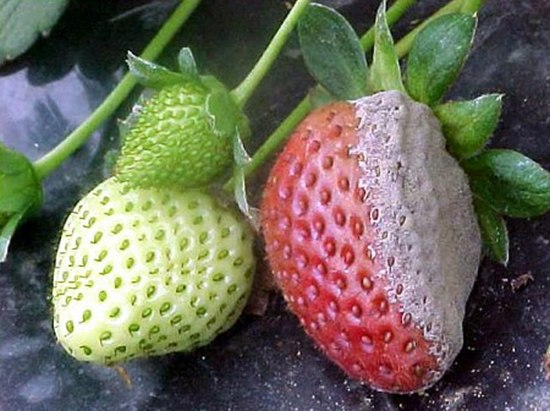
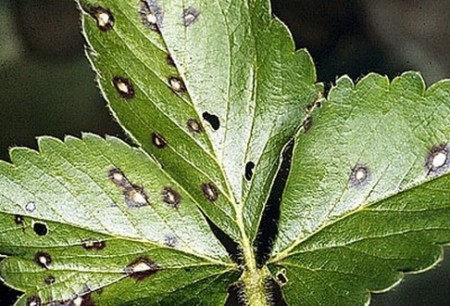
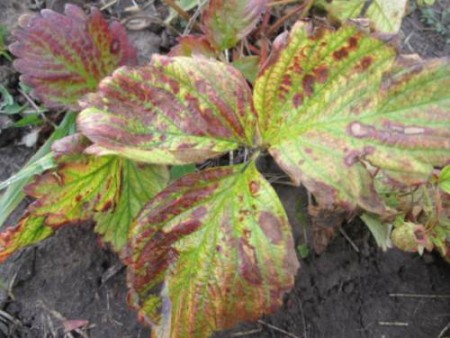
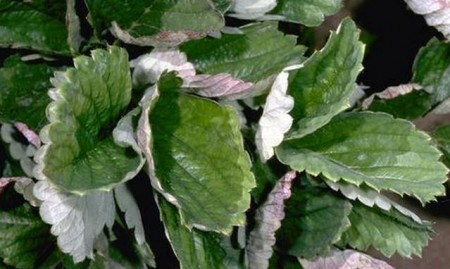
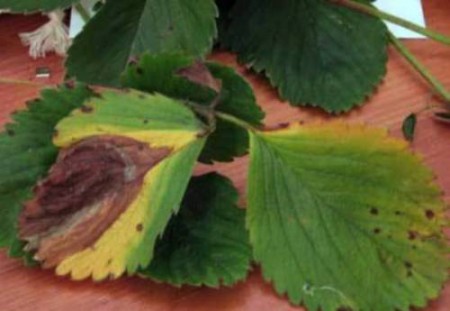
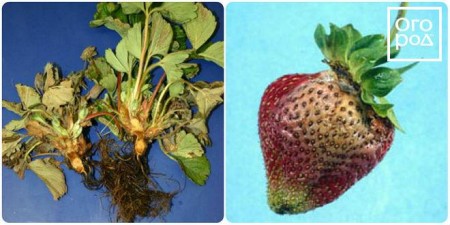

 (6 ratings, average: 4,33 out of 5)
(6 ratings, average: 4,33 out of 5) CUCUMBERS NEVER GET SICK, I'VE BEEN USING ONLY THIS FOR 40 YEARS! I SHARE A SECRET WITH YOU, CUCUMBERS ARE LIKE THE PICTURE!
CUCUMBERS NEVER GET SICK, I'VE BEEN USING ONLY THIS FOR 40 YEARS! I SHARE A SECRET WITH YOU, CUCUMBERS ARE LIKE THE PICTURE! You can dig a bucket of potatoes from each bush. Do you think these are fairy tales? Watch the video
You can dig a bucket of potatoes from each bush. Do you think these are fairy tales? Watch the video
 How our fellow gardeners work in Korea. There is a lot to learn and just fun to watch.
How our fellow gardeners work in Korea. There is a lot to learn and just fun to watch. Eye trainer. The author claims that with daily viewing, vision is restored. They don't charge money for views.
Eye trainer. The author claims that with daily viewing, vision is restored. They don't charge money for views. A 3-ingredient cake recipe in 30 minutes is better than Napoleon. Simple and very tasty.
A 3-ingredient cake recipe in 30 minutes is better than Napoleon. Simple and very tasty. Therapeutic exercises for cervical osteochondrosis. A complete set of exercises.
Therapeutic exercises for cervical osteochondrosis. A complete set of exercises. Which indoor plants match your zodiac sign?
Which indoor plants match your zodiac sign? What about them? Excursion to German dachas.
What about them? Excursion to German dachas.